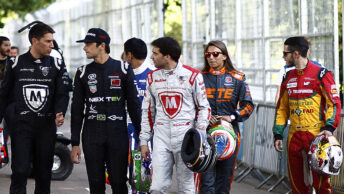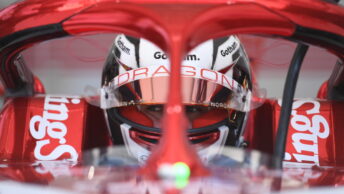Formula E is known for its street circuits; iconic locations, if not always the perfect circuit, they bring racing to people who’d probably ignore it if you hid it away on some remote, windswept permanent circuit, and take advantage of Formula E’s lack of fumes or noise to be able to go where other series can’t.
Everyone wants to race in the centre of Paris – it’s just only Formula E that can convince authorities to let them. These locations do come with limitations, however. You can’t knock down part of Les Invalides to make a better corner.
2016-17 Formula E champion Lucas di Grassi is one of three drivers involved in working on track design, representing the drivers’ interests in removing things like the extremely unpopular false chicanes and reviewing incidents. Asked in Diriyah how the tracks compared now to Formula E’s early seasons, and ahead of Formula E’s first night race, di Grassi was typically philosophical.
“Formula E tracks are not evolving as fast as the car. It’s not the fault of anyone, it’s just because it’s extremely difficult to move tracks like Paris, like New York, it’s extremely difficult to do – if you want to do a Formula 1 track or an LMP track, it’s a different magnitude – Paris, of course, you cannot be there.” he said, reflecting on seven seasons of improvement in the series.
“So the tracks that were originally designed, in the beautiful centres of the cities are amazing, but they were made for a much slower car. I think now, especially when you go to Gen3, we’ll be able to go to different tracks, we’d be able to go maybe to a little bit more of the traditional tracks, like we’re racing Valencia this year.”
Formula E’s trip to Valencia’s Circuit Ricardo Tormo – where pre-season testing has been held for four years – is an unplanned one, born from pandemic-induced necessity. But it’s also an in interesting opportunity for a championship that’s fiercely resisted running ‘traditional’ circuits – for good reasons, from visibility to the inevitable comparison to combustion series – to experiment with working there.
Di Grassi had a more radical proposal; “In my view, when we go to these tracks I would really recommend to have a race at night, with the lights on the car because [the Gen2] car with lights will look just amazing. In a circuit with some lights, maybe one third of the lights we have [in Diriyah] and with lights in the car, the halo; you can put LEDs on the car to show the sponsors.
“It could be a way to approaching normal circuits in an exciting way.” Futuristic aesthetics are part of what makes Formula E cool – but only really appeared on the cars and in photography, where di Grassi suggests taking them to track design. “I even suggested putting LEDs on the track edges so you don’t need to illuminate the whole track,” he said. “The edges of the track have a light that you can see – it would be very cool, TRON-style, very futuristic. These are much cheaper than putting in all these structures for the illumination, and then you do the race at dawn with some lights in the car.”
Formula E cars have run with lights during test days. The winter start of Season 7 (2020-21) meant teams, all based in the northern hemisphere, had limited light to run in during an allocated test day so some fitted lights to the car to try and maximise running.
Di Grassi’s concept was typically thoroughly developed, “The manufacturers, they could put their own lights – so it looks like more of a road car scenario. They can actually have a little bit more identity for their own cars, but only with the lights, no improvement in aerodynamics. Or if you don’t want to put lights, you have to put the ballast to compensate for the weight – you can do it in a way that there is no advantage and it’s just aesthetics.
“Plus the lights needs to be strong enough that you get a certain number of lumen but the teams will do it anyway because it’s good for the driver to have more lights, like in Le Mans.” He said, evoking an iconic circuit Formula E will probably have to wait a few generations yet to visit, “So I would say this direction for Gen3, this direction for an evolution of the series is good, but we’re never going to lose the city centre racing, I think that’s also good and that’s why I think we have to have a modular approach.”
One of the unique features of electric cars, compared to combustion, is that you can set varying power levels. You can’t simply power-limit or boost a combustion engine, mid-race, in a way that’s easy to regulate – whereas with an electric vehicle, it’s easy to change the maximum amount of power that the car can draw from the battery. Formula E already does this, with different power levels between qualifying (250kW) and the race (200kW) and then even mid-session, with Attack Mode adding an extra 35kW to the top end, if a driver puts the pedal to the floor.
Di Grassi believes the series should use that advantage to adapt the car to different circuits, as a way of keeping Formula E’s essential tracks while adding new ways of racing. “350kW, in a track like Paris – it’s just too much and I think pretty much all the drivers will agree,” he said. “You would stay flat out for maybe 10 percent of the the lap because with these tyres, with this kind of grip level, you can’t and then it becomes too dangerous or too expensive to build the tracks because we need longer run off areas, we don’t have that, they’d need to put special barriers, the price goes up. So I would do much more of a modular championship that the car has the potential to go to 400, 500kW in tracks like Valencia.”
“Then when you go to Paris, we can race at 200, 250. So there is not a spec power for every track and you adapt the car to the tracks so we can race whenever we want to, race with cost effectiveness and we don’t compromise.” He explained, “When we’re in the circuits we’ll look fast, in Paris we will look fast anyway, and then you can change the power and even go to 265 or 238, it’s just a software restriction. So it’s very easy to do stuff like that, it’s not like a combustion engine – you just you have a sensor on the battery and you know how much is going out. It’s very easy to like we do for race and qualifying and Attack Mode and it’s just it’s just a software setting.”
Formula E’s cost efficiency has been a selling point, especially given its prominent locations, and that’s become ever more pressing as manufacturers are squeezed by COVID. Di Grassi said this modular approach to power would provide the championship with more flexibility, “So I would go to this direction. I was very clear, from a couple of years ago, I think that’s the direction that will make this series cheaper to operate for Formula E because a track like Valencia will be much cheaper to do than Paris. But you keep the core elements; you keep Hong Kong, you keep Paris and New York and keep the key races in cities, you have the public there, which is the core of the championship.
“But you start also going to more aggressive venues, with a faster car. So this is my theory, for Gen3, at least. That’s a good future for me. “
Formula E races next on an adapted Rome Street Circuit, on 10th April. Find out more about the Season 7 calendar here.





